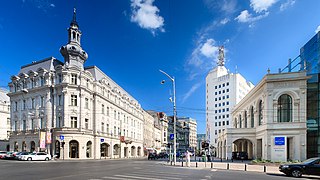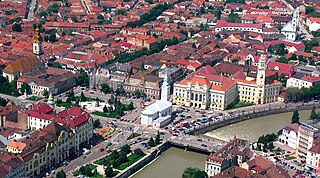 W
WBogdanovka was a concentration camp for Jews that was established in Transnistria Governorate by the Romanian authorities during World War II as part of the Holocaust.
 W
WBucharest is the capital and largest city of Romania, as well as its cultural, industrial, and financial centre. It is located in the southeast of the country, at 44°25′57″N 26°06′14″E, on the banks of the Dâmbovița River, less than 60 km (37.3 mi) north of the Danube River and the Bulgarian border.
 W
WDorohoi is a city in Botoșani County, Romania, on the right bank of the river Jijia, which broadens into a lake on the north.
 W
WGura Humorului is a town in Suceava County, north-eastern Romania. It is situated in the historical region of Bukovina. Gura Humorului is the seventh largest urban settlement in the county, with a population of 12,729 inhabitants, according to the 2011 census. It was declared a town in 1904 and it became a resort in 2005. The town administers the former village of Voroneț, site of Voroneț Monastery.
 W
WIași, also referred to mostly historically as Jassy, is the second largest city in Romania and the seat of Iași County. Located in the historical region of Moldavia, it has traditionally been one of the leading centres of Romanian social, cultural, academic and artistic life. The city was the capital of the Principality of Moldavia from 1564 to 1859, then of the United Principalities from 1859 to 1862, and the capital of Romania from 1916 to 1918.
 W
WOradea is a city in Romania, located in Crișana, a sub-region of Transylvania. Seat of the Bihor county, Oradea is one of the most important economic, social and cultural centers in the western part of Romania. The city is located in the north-west of the country, nestled between hills on the Crișana plain, on the banks of the river Crișul Repede, that divides the city into almost equal halves.
 W
WRădăuți is a city in Suceava County, north-eastern Romania. It is situated in the historical region of Bukovina. Rădăuți is the third largest urban settlement in the county, with a population of 23,822 inhabitants, according to the 2011 census. It was declared a municipality in 1995, along with two other cities in Suceava County: Fălticeni and Câmpulung Moldovenesc. Rădăuți covers an area of 32.30 km2 (12.47 sq mi) and it was the capital of former Rădăuți County.
 W
WSighetu Marmației, until 1960 Sighet, is a city (municipality) in Maramureș County near the Iza River, in northwestern Romania.
 W
WȘimleu Silvaniei is a town in Sălaj County, Crișana, Romania with a population of 16,066 people. Is located near the ancient Dacian fortress Dacidava.
 W
WSiret is a town, municipality and former Latin bishopric in Suceava County, north-eastern Romania. It is situated in the historical region of Bukovina. Siret is the 11th largest urban settlement in the county, with a population of 7,721 inhabitants, according to the 2011 census. It is one of the oldest towns in Romania and was the capital of the medieval Principality of Moldavia during the late 14th century. Furthermore, the town administers two villages: Mănăstioara and Pădureni.
 W
WThe Transnistria Governorate was a Romanian-administered territory between the Dniester and Southern Bug, conquered by the Axis Powers from the Soviet Union during Operation Barbarossa and occupied from 19 August 1941 to 29 January 1944. Limited in the west by the Dniester river, in the east by the Southern Bug river, and in the south by the Black Sea, it comprised the present-day region of Transnistria and territories further east, including the Black Sea port of Odessa, which became the administrative capital of Transnistria during World War II.